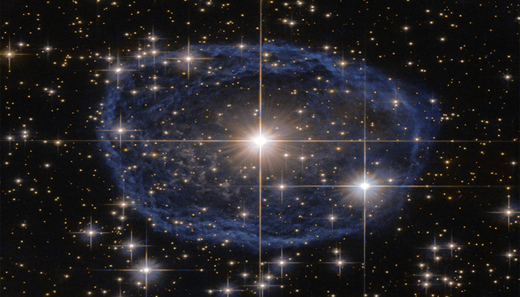NASA’s Hubble spots blue bubble encircling Wolf-Rayet star!
Mangalore Today News Network
New Delhi, Feb 27, 2016: NASA’s space telescope Hubble was launched into space in 1990. 16 years later, the largest space telescope still remains in operation.

With its 2.4-meter (7.9 ft) mirror, near ultraviolet, visible and near infrared spectra, Hubble Space Telescope (HST) has sent back extremely high-resolution images with negligible background light. Hubble has recorded some of the most detailed visible-light images ever, allowing a deep view into space and time.
Many Hubble observations have led to breakthroughs in astrophysics, such as accurately determining the rate of expansion of the universe.
This time, NASA has released another image beamed back by Hubble, which shows a bright and shining Wolf-Rayet star, also known as WR 31a, located about 30,000 light years away in the constellation of Carina (The Keel).
But that’s not all! The star seems to be enclosed in a distinctive blue bubble, called Wolf-Rayet nebula.
According to NASA, the bubble is an interstellar cloud of dust, hydrogen, helium and other gases. Created when speedy stellar winds interact with the outer layers of hydrogen ejected by Wolf–Rayet stars, these nebulae are frequently ring-shaped or spherical. The bubble — estimated to have formed around 20,000 years ago — is expanding at a rate of around 220,000 kilometers (136,700 miles) per hour!
- Missing II PUC Student Diganth found in Udupi after 10-day search
- Daylight burglary: Gold ornaments stolen from house in Vittal
- Illegal cattle transport: Three arrested after car crash near Gangolli
- District BJP stages protest; alleges injustice to DK in state budget
- Deputy Lokayukta inspects Varamballi waste unit, Kaup dumping yard
- Attempt to deactivate mobile jammers: Case filed against 9 prisoners
- Moobidri: Teacher dies in scooter-car collision
- Former deputy mayor Mohammad Kunjathbail passes away
- MP Capt Brijesh Chowta flags off International Stand-Up Paddling event at Sasihithlu beach
- Upset over delay in getting mobile phone, girls kills self in Udupi
- Budget aimed at appeasing minorities, says BJP
- KCCI reaction to Karnataka Budget 2025
- Kaavi artist from Udupi exhibits his work at Amrit Udyan in Rashtrapati Bhavan premises
- Delhi CM Rekha Gupta-led cabinet approves ₹2,500 monthly aid for women
- After Ranya Rao’s arrest, CBI to probe international gold smuggling ring
- In a first, all-women crew runs Vande Bharat on International Women’s Day
- Elderly woman falls after wheelchair delay, Air India flags late arrival
- Jinnah must be happy with Siddaramaiah’s budget, says CT Ravi
- Chess star to Space scientist: Women achievers take over PM Modi’s X handle
- Two women, including Israeli tourist, raped near Hampi
- Over 140 killed in clashes between Syrian forces and Assad loyalists
- Actor Ranya Rao admits to role in gold smuggling; DRI gets 3-day custody
- Relief for Siddaramaiah’s wife in MUDA case, probe agency summons cancelled
- India, China ties made positive strides after PM Modi-Xi meet: Chinese Minister
- Siddaramaiah defends guarantee schemes, targets Centre for state’s fiscal challenges
- Court remands Maoist Lakshmi to six-day police custody
- Sandhya Shenoy honored with Society for Materials Chemistry Medal-2024
- White Cornus Apartment in Mangaluru
- City girl wins first place in state-level spell bee competition
- Alleged ‘Love Jihad’ Case in Mangaluru: Woman left home voluntarily, says police
- Girl fatally struck by reckless two-wheeler near Belman
- New residential complex for the judges inaugurated in Mangaluru
- Absconding accused nabbed after 8 years
- Truck with cylinders turns turtle in Beltangady
- Bhoota Kola artist dies of cardiac arrest
- Development of the country should be our goal: Ganesh Karnik
- Container truck gets stuck under Modankap railway bridge
- Truck crushes bike’s pillion rider near BC Road
- Head constable dies of heart attack
- Udupi: PDO dismissed over financial irregularities
- CITY INFORMATION
- TRAVEL
- TOURIST INFORMATION
- HEALTH CARE
- MISCELLANEOUS




 Write Comment
Write Comment E-Mail To a Friend
E-Mail To a Friend Facebook
Facebook Twitter
Twitter  Print
Print 




